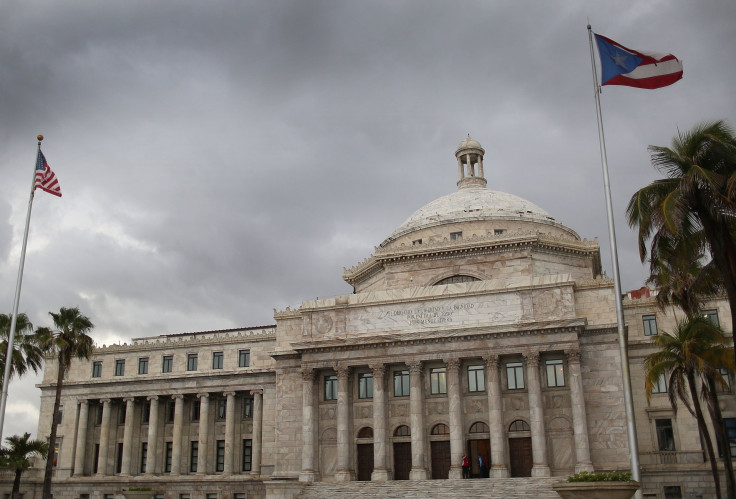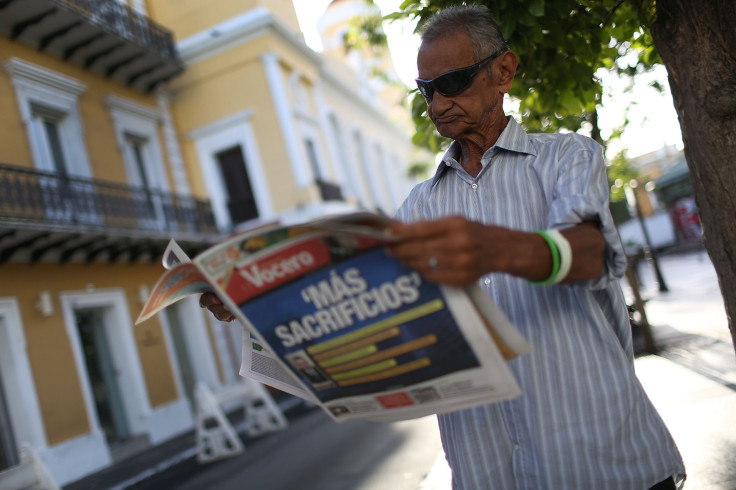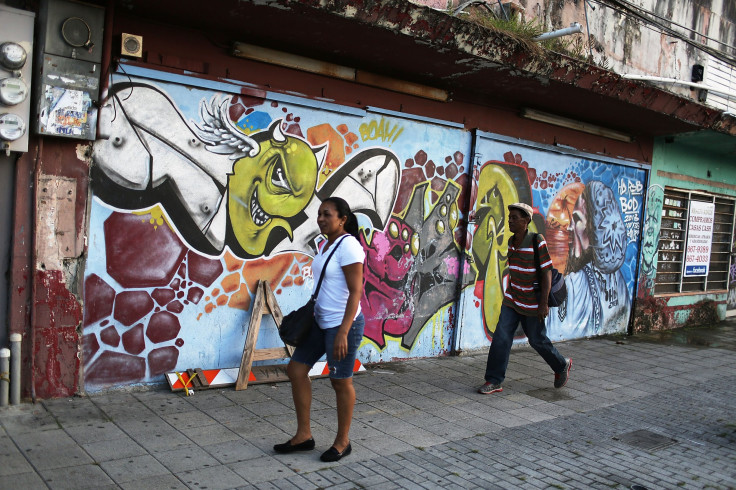Puerto Rico Debt Crisis: Default On Looming $422M Payment Could Worsen Financial Chaos On The Island

Puerto Rico’s long-simmering debt crisis could roar to a boil next week if the U.S. territory misses a critical bond payment.
The island will likely default on the $422 million it owes bondholders by a May 2 deadline, observers say. If it does, Puerto Rico will face an accelerated timeline for paying the full balance on those bonds. Yet the government says it can’t make those payments without cutting essential services, like electricity and healthcare, for the island’s 3.5 million residents.
For investors in Puerto Rico’s $72 billion of debt — including U.S. retirement funds, mutual funds, hedge funds and individual Americans — the looming debt default raises the risk that investors won’t see the full return on their investments, if they see any money at all. It also guarantees a long slog of legal battles in San Juan and Washington as bondholders seek to reclaim what’s owed.
Puerto Rico’s decadelong recession will deepen, while residents — nearly half of whom live in poverty — could see public services decline further as the government scrambles to fulfill its debt obligations. Business owners on the island will likely struggle to raise capital and grow their companies as the unfolding crisis darkens the financial market’s view of the island.
“It’s chaos. It’s just chaos,” said Edwin Meléndez, who directs the Center for Puerto Rican Studies at Hunter College in New York City.
This scenario already started to unfold to a lesser extent after Puerto Rico defaulted on $174 million in January. After the potential May 2 default, the commonwealth next faces a July 1 deadline for $2 billion in principle and interest payments.
But the chances Puerto Rico can scrape together funds to meet those obligations are slim to none, said David Fernandez, a public finance attorney at Buchanan, Ingersoll & Rooney in New York who follows Puerto Rico’s debt crisis closely. “If this continues in a downward spiral, the lights will eventually go off in the commonwealth. That’s the doomsday scenario,” he said.
“The hope would be that reasonable minds would come together, find a feasible solution that works toward keeping the lights on and creates an opportunity for payment to occur,” he added. “Eventually somebody will have to blink.”
So how did Puerto Rico find itself holding debt worth more than Kenya’s entire economy? And what can be done to fix it?
$72 Billion Of ‘Unpayable’ Debt
Puerto Rico’s government began borrowing heavily in recent years to counter its shrinking economy and dwindling tax base. The Caribbean island was once a major hub for U.S. manufacturers and pharmaceutical companies — primarily thanks to Section 936 of the federal tax code, which exempted U.S. industries from income taxes in Puerto Rico.
But after Congress passed legislation in 1996 to phase out the tax exemption, companies soon shuttered their factories and thousands of workers lost their jobs. The island didn’t have a backup plan to promote economic growth, and for the last 15 years the economy has largely contracted.
Puerto Rico’s tax revenue shrank swiftly with corporate flight, and it continued eroding as Puerto Ricans, who are U.S. citizens, left the island in numbers not seen in more than half a century. Around 84,000 people left Puerto Rico for the mainland U.S. in 2014, up nearly 40 percent from 2010, the American Community Survey found.
All the while, public officials failed to rein in spending and manage the budget. Public agencies and utility monopolies drew criticism for operating inefficiently.
Against this backdrop, the government issued a blizzard of municipal bonds to help it keep hospitals running, schools open and roads paved. Puerto Rico eventually amassed $72 billion in debts from dozens of groups, more than half of whom hold general-obligation bonds or debt from government-owned corporations.
Then came a startling admission in June 2015 from Puerto Rico’s governor, Alejandro García Padilla. “The debt is not payable,” he said in a televised broadcast. “There is no other option. I would love to have an easier option. This is not politics, this is math.”

It’s All About the Politics
While Congress’ decision to remove the Section 963 tax break helped precipitate the debt crisis, a second move by Congress has kept Puerto Rico from fixing the problem. Unlike the 50 states, Puerto Rico is excluded from Chapter 9 of the U.S. bankruptcy code, which allows municipal governments and public agencies to restructure their debt during a crisis.
Puerto Rico wasn’t always left out. In 1984, Congress agreed to exempt the commonwealth from Chapter 9, for no precise reason. Puerto Rico recently passed its own law allowing utilities and local governments to declare bankruptcy, but a U.S. appeals court struck it down last summer.
Since Puerto Rico can’t seek bankruptcy protection, the island is now depending on Congress to pass measures to extend debt payment deadlines, create a fiscal oversight board, and give Puerto Rico more flexibility in paying down debt and for critical services — from electricity and drinking water to public hospitals and schools. Puerto Rico has already closed over 100 schools, and last week it shuttered a children’s hospital because it couldn’t pay the staff.
Legislators in the U.S. House have so far failed to get a bill out of committee to help Puerto Rico. Progress recently hit a wall after the Center for Individual Freedom, a dark money group, backed a $200,000 ad campaign that branded the effort as a government bailout. Hedge fund managers in particular have opposed any deal that would delay Puerto Rico’s debt payments.
House Majority Leader Kevin McCarthy said this week that Congress wouldn’t step in ahead of the looming May 2 debt payment. But he told reporters he is “hopeful” a bipartisan bill could emerge from the House before the $2 billion payment deadline in July.
Yet even if Congress does pass relief measures, it’s unclear whether those would save Puerto Rico from defaulting. The commonwealth will still likely miss its May 2 payments, regardless of congressional action, because its treasury and the Government Development Bank have “insufficient liquidity for upcoming debt payments,” the credit ratings agency Moody's said in an emailed research note.
“In the absence of federal action, the defaults will encourage bondholder litigation, likely prolonging efforts to restructure Puerto Rico’s approximately $72 billion of debt,” it said.

Why It Could Get Much Worse
Bondholders and creditors are most certainly likely to sue Puerto Rico to collect what they’re owed. Citizen groups are also likely to file lawsuits as the commonwealth curbs services and limits public agencies to service its debt. Puerto Rico already came under fire for failing to pay companies that serve mentally disabled people on the island. A federal judge last week ordered the island’s health department to pay those firms immediately.
“Every dollar that goes to repay the debt — in the context of declining revenues — will be taken out of services to the population,” Meléndez of Hunter College said. “There’s no other way around it. Where else is the money going to come from?”
Puerto Rican legislators have attempted to adopt their own plan for restructuring the $72 billion debt. Earlier this month, policymakers proposed to reduce a $49 billion slice of the total pie to up to $37.4 billion by exchanging existing debt for two types of new bonds: about $28 billion of base bonds and about $2 billion of tax-exempt capital appreciation bonds.
But David Fernandez, the public finance attorney, said bondholders will have much less incentive to agree to a restructuring plan if Puerto Rico defaults on its debts. When that happens, the island will be required to pay back lenders at an accelerated rate, meaning the bondholders would get their money more quickly than under a restructuring deal — assuming the island can pay at all.
Unless Congress steps in to help wrangle the mess it helped create “it’s going to get much worse” for Puerto Rico, Fernandez said. “The question will become how much worse.”
© Copyright IBTimes 2024. All rights reserved.





















